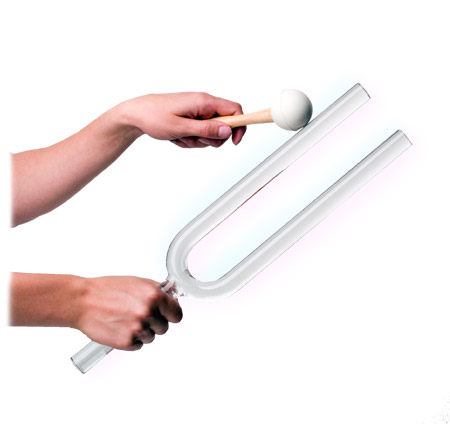The History of Sound Healing
In 1550 in Pavia, Italy, Girolamo Cardano, a physician, mathematician and astrologer, noticed how sound was being perceived through the skin. In 1553 in Padua, Italy, H. Capivacci, a physician, noticed that this knowledge of sound being perceived through the skin might be used as a diagnostic tool for differentiating between hearing disorders located in the middle ear or in the acoustic nerve.
In 1684, German physician G. C. Schelhammer tried using a common cutlery fork to enhance the experiments that Cardano and Capivacci were working on.
In 1711 in England, Royal trumpeter and luteist, John Shore, created the first tuning fork. At that time, he lovingly and jokingly called it a pitch fork. It was made of steel and had a pitch of A423.5.
In 1800, German physicist E.F.F. Chladni, along with others, constructed a complete musical instrument based on sets of tuning forks.
In 1834, J.H. Scheibler presented a set of 54 tuning forks covering ranges from 220 Hz to 440Hz. Later, in Paris, J. Lissajous constructed a tuning fork with a resonance box. Also in Paris, German physicist K. R. Koening invented a tuning fork which was kept in continuous vibration by a clockwork. In 1863 in Heidelberg, physiologist H. Helmholtz, used sets of electromagnetically powered tuning forks for his experiments on the sensations of tone.
Tuning forks were indispensible instruments for producing defined sinusoidal vibrations and used as a diagnostic tool in otology. The most common system of determining the pitch of all twelve notes in a octave is the Equal temperament. The standard pitch here is A440. As a side note, equal temperament was proposed by Aristoxenus, a pupil of Aristotle, and had been in use in China for some centuries.
Mr. Hipkins, the head piano tuner in 1846, was instructed by Walter Broadwood to instruct his piano tuners in the use of equal temperament. To do this, he used two tuning forks; one for meantone at A433.5 and one for equal temperament at A436.
 The Ancient History of Sound Healing
The Ancient History of Sound Healing
Even though musicians were among the first people to work with pitch, scientist enjoyed sharing knowledge and use of the tuning fork also. As far back as 583 BC, when the Greek philosopher, Pythagorus, made a device called the monochord and set the pitch to 256Hz.
The Egyptians and Greeks used the monochord to make intricate mathematical calculations. It wasn’t until around 1834 when a group of German physicists was able to use a mechanical stroboscopic device, that they were able to determine that the pitch of the tuning fork was at A440cps (which later was expressed as A440Hz).
Even though the pitch of the note “A” in the 17th century varied from 373.3 Hz to 402.0 Hz, on July 27, 1987, the International society of Piano Builders and Technicians unanimously support A=440 Hz. as the international pitch standard for piano manufacturers and for modern piano and orchestral tuning.
About the author:
Charles has studied with shamen and alternative healers for over 26 years. He is a Medical Intuitive, Reiki Master, Ordained minister, Certified religious counselor and Certified Spiritual healer. Check out http://www.thefamilyoflight.net/ for more of his works.


 Fill out the form below to sign up to our free natural health and healing newsletter and stay up to date on our latest articles about holistic healing therapies and effective home remedies for common ailments. As a thank you for joining our newsletter, we’ll also send you
Fill out the form below to sign up to our free natural health and healing newsletter and stay up to date on our latest articles about holistic healing therapies and effective home remedies for common ailments. As a thank you for joining our newsletter, we’ll also send you